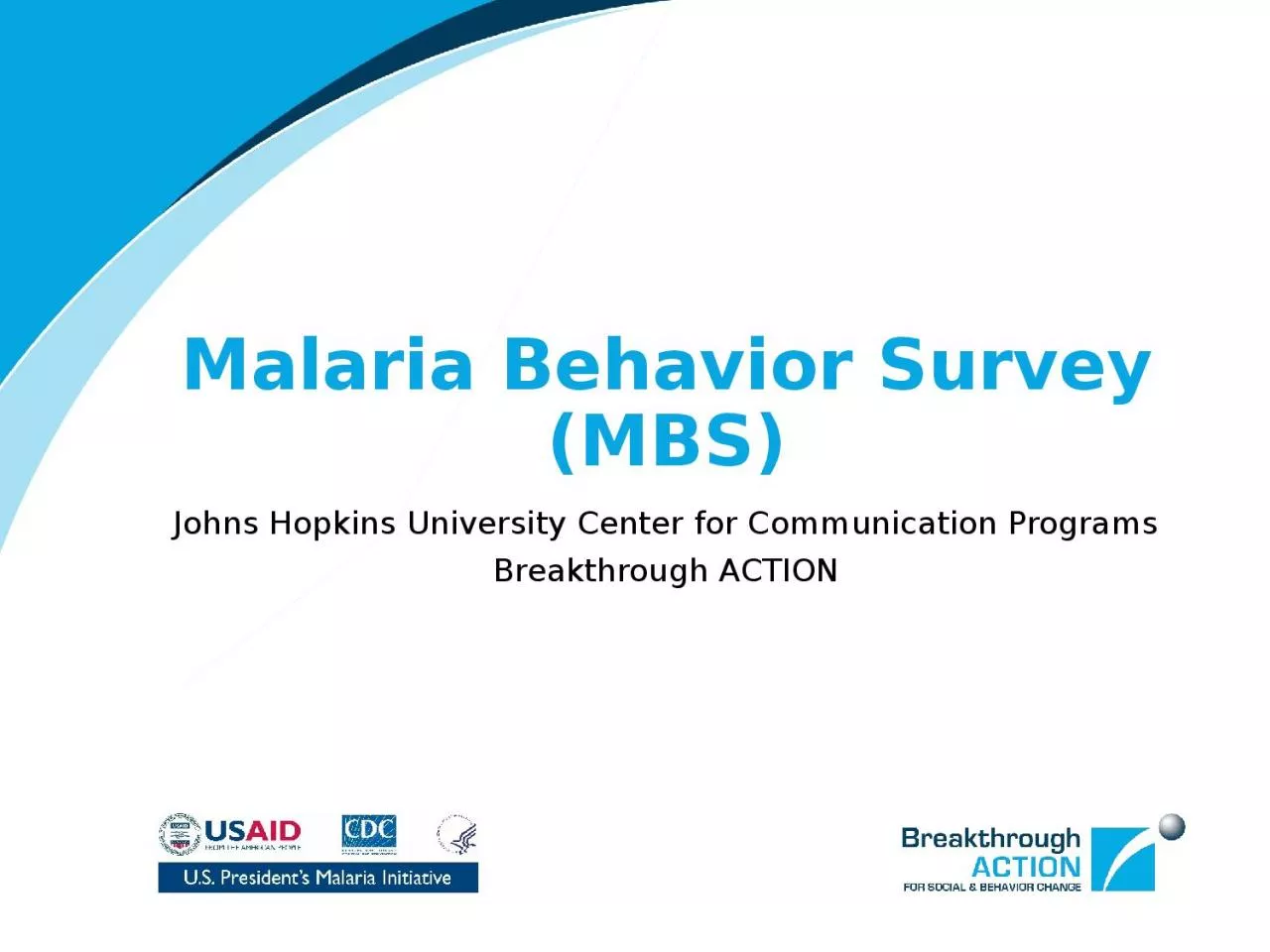

Johns Hopkins University Center for Communication Programs Breakthrough ACTION Introduction Malaria elimination relies heavily on the adoption of appropriate behaviors Effective SBC interventions need to incorporate determinants of malariarelated behaviors ID: 1036547
Download Presentation The PPT/PDF document "Malaria Behavior Survey (MBS)" is the property of its rightful owner. Permission is granted to download and print the materials on this web site for personal, non-commercial use only, and to display it on your personal computer provided you do not modify the materials and that you retain all copyright notices contained in the materials. By downloading content from our website, you accept the terms of this agreement.
1. Malaria Behavior Survey (MBS)Johns Hopkins University Center for Communication Programs Breakthrough ACTION
2. IntroductionMalaria elimination relies heavily on the adoption of appropriate behaviors.Effective SBC interventions need to incorporate determinants of malaria-related behaviors.Data on the determinants of malaria-related behaviors are lacking in most settings.
3. MBS ObjectivesInform SBC strategies and programs by: 1. Identifying and understanding the demographic, psychosocial and contextual factors associated with:The use and maintenance of mosquito nets;Adoption of the Intermittent Approach to Preventive Treatment of Malaria During Pregnancy (IPTp);Prompt and appropriate treatment of fever in children.SMC and IRS modules are also available2. Assessing exposure to malaria related SBC
4. MBS countries to date4Completed: Côte d’Ivoire: pilotSierra LeoneCameroonIn process: MalawiTanzaniaDemocratic Republic of Congo
5. Methodology: Sampling strategySelection of clustersUsing probability proportionate to sizeSelection of households randomly within clustersSelection of ParticipantsIn each household, interview all eligible women of reproductive age;In a third of households, interview one eligible man (spouse or partner of one of the eligible women).
6. Methodology: Data Collection ToolsThree questionnairesHouseholdWomen'sMen’sQuestions were informed by the ideation model
7. Theoretical FoundationIdeation Model of Social and Behavior Change
8. Key Ideational Concepts (1)Perceived threat:Perception of the severity of malariaPerceived vulnerability to malaria (or perception of its chances of being infected by malaria);Each of these concepts is measured by multiple statements that require respondents to indicate their level of agreement
9. Key Ideational Concepts (2)Knowledge:Causes and means of preventing malaria;Symptoms of malaria;Malaria testing and treatment;Recommended solutions: intermittent prevention; treatment of malaria during pregnancy;Recommended number of antenatal care visits.
10. Key Ideational Concepts (3)Perception of self-efficacy: Confidence in the ability to take specific measures to protect health.Take appropriate measures to protect household members against malariaIdentify the symptoms of malaria;Get enough ITNs for all household members;Quickly take a feverish child to a health facilityGet enough antenatal visits during pregnancy;Take the recommended doses of IPTp;Malaria treatment adherence
11. Key Ideational Concepts (4)Perceived effectiveness: Evaluate belief in the effectiveness of a recommended solution.Perception of the effectiveness of LLINsDiagnostic tests for malaria;Antimalarial drugs provided in health facilities;IPTp
12. Key Ideational Concepts (5)Interpersonal communication: Discussion of a question with other peopleTalk about malaria with the spouse;Talking about malaria with friends or relativesAttitudes: Beliefs and values that individuals have about a behavior.Preferences, use and care of ITNs, management of fever cases, malaria diagnostic test, IPTp.
13. Key Ideational Concepts (6)Descriptive Norms: Perceptions of the prevalence of behavior in the immediate environment.Use of ITNs, rapid search for care in case of fever, use of malaria diagnostic test in health facilities, prenatal visits, use of IPTp.Decision-making dynamics: Participation in decisions related to specific health issues in their householdSeeking care for a sick child, prenatal care and distribution of mosquito nets in the household.
14. Key Results Expected:Women’s QuestionnaireSociodemographic characteristicsITN use and careUse of health services for ANC and care-seeking for feverIdeation about:Malaria (in general)ITN use and careIPTp and ANC visitsCare seeking for fever in children under 5Malaria treatmentExposure to malaria SBC activities*Optional modules on IRS and SMC may also be used
15. Key Results Expected:Men’s QuestionnaireSociodemographic characteristicsITN use and careIdeation about:Malaria (in general)ITN use and careIPTp and ANC visitsCare seeking for fever in children under 5Malaria treatmentExposure to malaria SBC activities*Optional modules on IRS and SMC may also be used
16. Key Results Expected:Household QuestionnaireList of household membersCharacteristics of the householdHousehold access to health carePopulation ITN indicatorsUseAccess and Use given access
17. Partnerships and CollaborationsPartnerRoleActionNMCPKey ContributorContribute to the design and implementation of the study. Disseminate and use results.PMIFunderProvide funding and technical guidance. Use results for MOP and program design.Local Research Firm (TBD)ImplementerHired (by Breakthrough ACTION) for data collection.Breakthrough ACTIONCoordinatorIn charge of designing and implementing the study. Disseminate and use results.Explore opportunities for capacity strengthening where possibleNMCPSBC TWGLocal Research Firm
18. MBS Advisory GroupMembersNMCPPMIBreakthrough ACTIONTerms of referenceKeep MBS activities moving from the planning phase through to final disseminationAdvise on IRB, local permissions and geographyMake key decisionsOvercome bottlenecksOrganize dissemination18
19. Timing of the surveyIdeal timing is near the end of rainy season, or shortly afterwards19
20. MBS Steps20Dialogue and planning with NMCP and PMISampling scheme and zoning, geographic scope and timelineSecure necessary funding once geography and sampling is finalizedAdjust and finalize data collection toolsLocal Ethics Committee submissionJHU Ethics Committee submissionSelection of local research firmObtain local permissionsTrain data collectorsImplement and supervise field workData analysisParticipatory results interpretation workshopReport writing and dissemination
21. Questions?